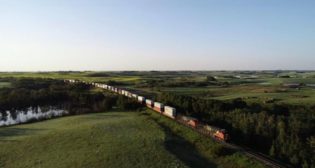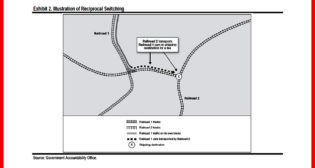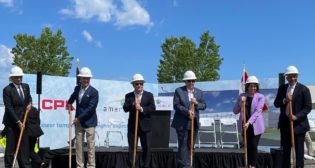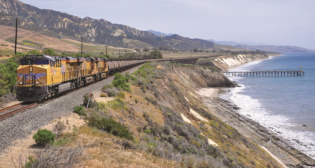
AAR comments to PHMSA stress efficiency as well as safety
Written by William C. Vantuono, Editor-in-ChiefAAR urged PHMSA to:
• Require 40 mph speed limits only in federally designated high-threat urban areas for trains with at least one legacy DOT-111 tank car moving flammable liquids, as the industry agreed to implement for crude oil by July 1, 2014, as part of the voluntary agreement with DOT. This additional speed restriction would be on top of the industry’s self-imposed nationwide 50 mph limit for trains with 20 or more cars loads of any hazardous material.
• Refrain from requiring electronically controlled pneumatic (ECP) brakes on tank cars used to move flammable liquids, “as they are very costly systems not justified in terms of improved safety benefits, and could result in negative operational impacts on the network.” AAR also noted that under its voluntary agreement with DOT, railroads already have addressed braking systems for trains moving crude oil, using either distributed power or two-way-telemetry end-of-train devices on trains carrying crude oil.
• Upgrade federal tank car specifications by adopting a new federal requirement for a half-inch-thick shell for new cars in flammable liquid service, plus a one-eighth-inch-thick jacket and thermal protection. AAR also urged PHMSA to require full-height head shields, “appropriately sized” pressure relief devices, bottom-outlet handle protection, and top-fittings protection. “From a safety standpoint, these proposed new federal standards would dramatically reduce the likelihood of a release in an accident by more than 81% over current non-jacketed DOT-111 tank cars.”
• Require the “aggressive retrofit or phase-out” of existing flammable liquid tank cars as soon as possible while still enabling the industry to meet increased demand to move flammable liquids by rail. “Existing jacketed tank cars should be retrofitted with appropriately-sized pressure relief devices and bottom-outlet handle protection, while non-jacketed legacy DOT-111 cars should be retrofitted with jackets, thermal protection, full-height head shields, appropriately-sized pressure relief devices, bottom-outlet handle protection, and top-fittings protection. Newer CPC-1232 cars without a jacket should be retrofitted with jackets, thermal protection, full-height head shields, appropriately-sized pressure relief devices, and bottom-outlet handle protection. The comments also support placing a priority on cars used for crude oil and ethanol since they account for most unit train service for flammable liquids, with the highest priority being legacy unjacketed DOT-111 tank cars carrying crude oil, which should be retrofitted within three years.” AAR has asked that CPC-1232 cars, which meet a voluntary industry safety standard implemented in October 2011, be allowed six years for retrofitting.
“Rail traffic is rebounding to pre-recession levels, including growth in everything from grain to automobiles to domestic energy resources like crude oil and ethanol,” said Hamberger. “There is a changing traffic mix on rail lines throughout the country. This has resulted in some service issues that highlight the importance of weighing consequences of new speed restrictions that could curb network fluidity and the railroads’ ability to meet demand to move more freight as America’s economy continues to grow. Railroads are proud of their hazardous materials safety record, which reflects steadfast attention to training and protocols, as well as a constant focus on safety improvement and advancement. They have been at the forefront of advocating for safer tank car standards and we believe the public supports regulation that weighs both safety and the ability to move people and goods in a timely and efficient manner.”
Commenting on PHMSA’s proposed requirement for ECP brakes on trains designated as HHFTs (High-Hazard Flammable Trains), Hamberger said such a measure “is neither justified by federal and industry safety data, nor practical given the industry’s intense focus on improving network fluidity. . . . The safety data simply isn’t there to justify implementing this complex and costly system—not to mention significant potential efficiency downsides.”
At the request of DOT Secretary Foxx earlier this year, AAR collaborated with oil industry customers represented by the American Petroleum Institute and identified the proposed new tank car standards for flammable liquids, as well as retrofit standards for tank cars currently used to move crude oil.
“Railroads have long supported improved tank car safety, and have a long history of collaborating with our customers and suppliers through the AAR Tank Car Committee and most recently thanks to the leadership of Secretary Foxx,” Hamberger said. “These new tank car specifications will greatly reduce the likelihood of a release due to an accident. We believe they should be implemented as aggressively as possible so that railroads can continue to provide the safe rail movement of flammable liquids our economy depends upon.”
In addition to filing comments on the NPRM, AAR submitted a response to PHMSA’s Advance Notice of Proposed Rulemaking (ANPRM) on oil spill response plans for HHFTs. “Similar to the significant voluntary operational steps taken by railroads around the movement of flammable liquids, railroads have invested tremendous resources and attention to address railroad and community preparedness,” Hamberger noted. “In response to PHMSA’s request for information, the railroads presented a possible regulatory text for railroad oil spill response plans that will augment the plans they already have in place today. Our approach to the proposed regulatory language exceeds the current federal requirements, and follows the logic and scope of regulations that apply to the pipeline industry. The proposed text addresses subjects such as: who is required to submit a plan, to whom the plan should be submitted, worst-case scenarios for discharge from a tank car, required response resources, as well as training and recordkeeping.”



